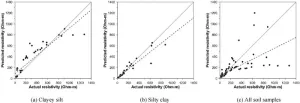Proper power grounding systems are necessary for maintaining the safety and reliability of critical electrical subsystem infrastructure, such as substations. Power grounding systems provide a low-resistance path for electrical fault currents to flow into the earth, preventing electrical shocks, fires, and damage to vital equipment. Investigation of soil resistivity is crucial for designing power grounding systems. For the most cost-effective and efficient grounding systems for electrical substations, it is imperative to carefully select sites with the lowest soil electrical resistivity. This also ensures optimal performance and safety. Therefore, accurate determination of soil resistivity is important, as inaccurate values can lead to faulty grounding systems.
The Electricity Generating Authority of Thailand has set criteria for the soil resistivity required for substations, with a threshold of less than 80 Ohm-meters. However, soil resistivity often fails to meet these requirements, highlighting the need for robust soil resistivity assessment methods. Many studies have investigated the relationship between soil resistivity and various geotechnical properties, emphasizing the influence of water content, unit weight of soil, salt content, clay content, and particle sizes. Despite these insights, there remains a need for a comprehensive predictive model that integrates the relationships between soil electrical resistivity and multiple geotechnical parameters.
To address this challenge, a research team, led by Professor Shinya Inazumi from the College of Engineering at Shibaura Institute of Technology, conducted a comprehensive investigation into the behavior and relationships between soil resistivity and geotechnical parameters in a controlled temperature and humidity environment. They also developed a predictive model based on their findings. Their study was made available online on August 08, 2024, and published in Volume 23 of the journal Results in Engineering in September 2024.
“At the heart of this study is the development of predictive models based on the relationship between soil electrical resistivity and key geotechnical properties. By developing robust correlation models, we aim to accurately predict soil resistivity under field conditions. This has significant implications for the design of grounding systems in electrical substations, particularly in regions with diverse soil types such as Thailand,” says Prof. Inazumi.
In the study, the researchers measured 30 soil samples from various representative locations within the power grid substation in Thailand, using a controlled laboratory environment to establish a robust correlation of resistivity with each geotechnical parameter. Three index geotechnical properties were selected to correlate with soil electrical resistivity: water content, known to strongly influence resistivity; plasticity index, representing the clay content; and dry density, representing soil density without water. Results revealed a clear relationship between soil resistivity and water content, with resistivity increasing with decreasing water content. However, the correlation between resistivity and plasticity index or dry density was found to be less significant, which the researchers attributed to the dominant influence of water content.
To address this issue, they further utilized nonlinear multiple regression analysis to study the combined effects of water content and other soil parameters. The coefficient of determination (r2), which explains how well a model fits the observed data, for the correlation of soil electrical resistivity, water content, and plasticity index, was found to be 0.8281, and 0.7742 for the correlation between electrical resistivity, water content, and dry density. These strong correlations suggest that a combination of water content, plasticity index, and dry density provides a reliable predictive model for soil resistivity.
However, the team also acknowledged the limitation of this model, which can currently predict soil resistivity of only cohesive soils with fine particles. This is due to the limited variety of soil samples used in the study. Fortunately, this limitation can be easily addressed in future research by including a broader and more diverse set of soil samples.
“This study provides a method for optimizing substation grounding designs, which are critical for protecting equipment and personnel from electrical faults. The results can reduce the need for extensive soil testing and modifications, cutting costs while maintaining regulatory compliance. Beyond electrical applications, predictive models developed in the study could also be adapted for environmental monitoring,” remarks Prof. Inazumi, highlighting the potential broader applications of their study.
Overall, this study breaks new ground in soil resistivity assessment, contributing to the cost-effective construction of ground systems for electrical substations and paving the way for safer and more reliable power supply, which is essential for stable economic growth.
***
Reference
DOI: 10.1016/j.rineng.2024.102696
About Shibaura Institute of Technology (SIT), Japan
Shibaura Institute of Technology (SIT) is a private university with campuses in Tokyo and Saitama. Since the establishment of its predecessor, Tokyo Higher School of Industry and Commerce, in 1927, it has maintained “learning through practice” as its philosophy in the education of engineers. SIT was the only private science and engineering university selected for the Top Global University Project sponsored by the Ministry of Education, Culture, Sports, Science and Technology and had received support from the ministry for 10 years starting from the 2014 academic year. Its motto, “Nurturing engineers who learn from society and contribute to society,” reflects its mission of fostering scientists and engineers who can contribute to the sustainable growth of the world by exposing their over 9,500 students to culturally diverse environments, where they learn to cope, collaborate, and relate with fellow students from around the world.
Website: https://www.shibaura-it.ac.jp/en/
About Professor Shinya Inazumi from SIT, Japan
Dr. Shinya Inazumi is currently a Professor at the College of Engineering at Shibaura Institute of Technology. He received his M.S. and Ph.D. degrees from Kyoto University in 2000 and 2003, respectively. He is renowned for his contributions to the field of geotechnical engineering. He received the Best Paper Award of The 13th International Conference on Geotechnique, Construction Materials and Environment in 2023, the Reiwa 2nd Year Japan Society for Materials Science Award from The Society of Materials Science of Japan in 2021, and also the ISSN Outstanding Researcher Award and ISSN Golden Research Award in 2020, among others. He has published over 350 articles that have received over 1000 citations. His broader research interests include civil engineering, geoinformatics, artificial intelligence and data science.
END





